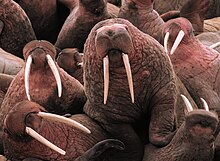| Otarioidea | |
|---|---|

| |
| A rookery of walruses (Odobenus rosmarus) | |

| |
| A male and female South American sea lion (Otaria flavescens) | |
| Scientific classification | |
| Domain: | Eukaryota |
| Kingdom: | Animalia |
| Phylum: | Chordata |
| Class: | Mammalia |
| Order: | Carnivora |
| Clade: | Pinnipedia |
| Superfamily: | Otarioidea J. E. Gray, 1821 |
| Subclades | |
| |
Otarioidea is a superfamily of pinnipeds that includes the families Odobenidae, Otariidae and their stem-relatives.[1][2] In the past when the pinnipeds were considered to be a diphyletic group of marine mammals, a few points of cranial and dental morphology suggested that the otarioids originated from a line of bears.[3] One extinct family, Enaliarctidae, was postulated to be otarioids that were a transitional clade between Hemicyoninae (an extinct subfamily of dog-like bears) and Otariidae.[3] Recent comprehensive studies have, however, since the 1990s found pinnipeds to be a monophyletic clade of aquatic arctoids.[1] There are a few authorities that place desmatophocids and odobenids as sister taxa to Phocidae in the clade Phocomorpha based on a few minor physiological features.[4]
References[edit]
- ^ a b Berta, A.; Churchill, M. & Boessenecker, R.W. (2018). "The Origin and Evolutionary Biology of Pinnipeds: Seals, Sea Lions, and Walruses". Annual Review of Earth and Planetary Sciences. 46: 203–228. Bibcode:2018AREPS..46..203B. doi:10.1146/annurev-earth-082517-010009.
- ^ Paterson, R. S.; Rybczynski, N.; Kohno, N.; Maddin, H. C. (2020). "A Total Evidence Phylogenetic Analysis of Pinniped Phylogeny and the Possibility of Parallel Evolution Within a Monophyletic Framework". Frontiers in Ecology and Evolution. 7 (457). doi:10.3389/fevo.2019.00457.
- ^ a b Mitchell, E. & Tedford, R. H. (1973). "The Enaliarctinae: a new group of extinct aquatic Carnivora and a consideration of the origin of the Otariidae". Bulletin of the AMNH. 151 (3). hdl:2246/1178.
- ^ McKenna, Malcolm C., and Susan K. Bell (1997). Classification of Mammals Above the Species Level. New York: Columbia University Press. 631 pp. ISBN 0-231-11013-8




Well, that’s interesting to know that Psilotum nudum are known as whisk ferns. Psilotum nudum is the commoner species of the two. While the P. flaccidum is a rare species and is found in the tropical islands. Both the species are usually epiphytic in habit and grow upon tree ferns. These species may also be terrestrial and grow in humus or in the crevices of the rocks.
View the detailed Guide of Psilotum nudum: Detailed Study Of Psilotum Nudum (Whisk Fern), Classification, Anatomy, Reproduction